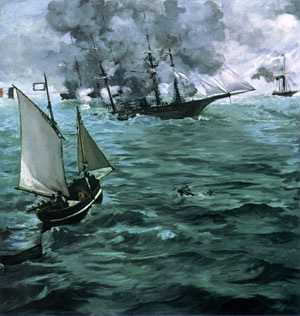A fresh sea breeze appears to be gusting through the art galleries of Northern Europe this summer. A fortnight ago I reviewed the excellent, compact exhibition at the Bowes Museum devoted to “Boudin, Monet and the Sea Painters of Normandy”. Earlier this week, another superb albeit rather larger exhibition on a maritime them opened at the Van Gogh Musuem in Amsterdam, entitled “Manet and the Sea”. While the show at the Bowes aims to put one of the supposedly lesser lights of Impressionism, Eugene Boudin, firmly on the map, the Van Gogh Museum’s exhibition takes a giant of French nineteenth-century painting, the multi-faceted Edouard Manet, and charts some of the less familiar waters of his oeuvre.
Manet (1832-83) is famous as a pioneer of what his friend and contemporary Charles Baudelaire termed “the painting of modern life”, and he remains most closely associated with those masterpieces, now world famous, in which he attempted to give a shape and a form to the new and sometimes disconcerting realities of life in the fast-changing world of mid-nineteenth-century Paris: the Dejeuner sur l’Herbe, an enigmatic pastoral in which a pair of bohemian dandies are seen enjoying a day out from the city in the company of a puzzlingly naked lady; Olympia, the portrait of a hard-faced Parisian prostitute reclining nude as she appraises her next client with an expression in which tough self-reliance and infinite world weariness are unforgettably blended; A Bar at the Folie-Bergeres, with its madonna-like barmaid at the end of her tether amid the glare and the glitter of the city’s new palace of booze and ephemeral entertainment. But throughout his life he also always felt the pull of the sea. Manet was not just a painter of the fascinating ephemeral centre, the confusion of the metropolis;...

Manet and the Sea at the Van Gogh Museum, Amsterdam
27-06-2004

